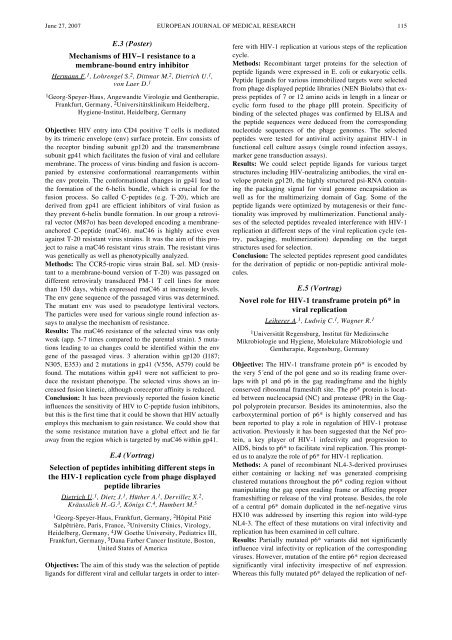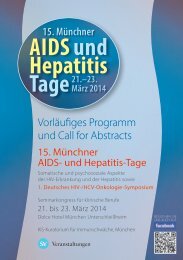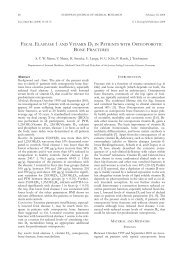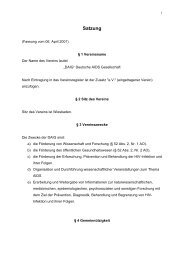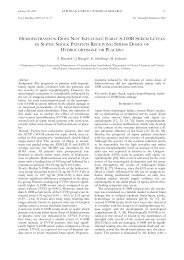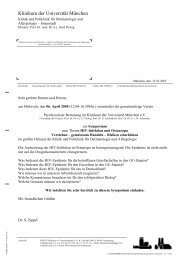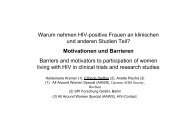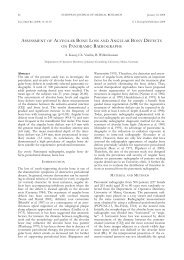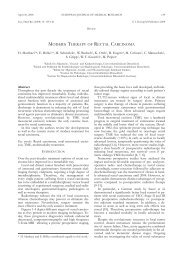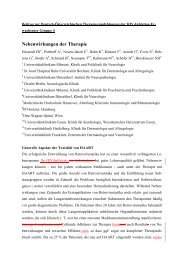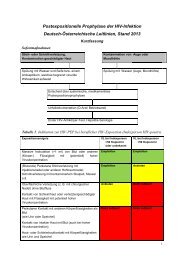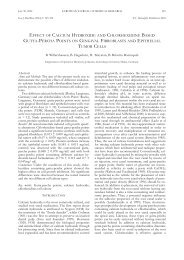European Journal of Medical Research - Deutsche AIDS ...
European Journal of Medical Research - Deutsche AIDS ...
European Journal of Medical Research - Deutsche AIDS ...
You also want an ePaper? Increase the reach of your titles
YUMPU automatically turns print PDFs into web optimized ePapers that Google loves.
June 27, 2007 EUROPEAN JOURNAL OF MEDICAL RESEARCH<br />
115<br />
E.3 (Poster)<br />
Mechanisms <strong>of</strong> HIV–1 resistance to a<br />
membrane-bound entry inhibitor<br />
Hermann F. 1 , Lohrengel S. 2 , Dittmar M. 2 , Dietrich U. 1 ,<br />
von Laer D. 1<br />
1 Georg-Speyer-Haus, Angewandte Virologie und Gentherapie,<br />
Frankfurt, Germany, 2 Universitätsklinikum Heidelberg,<br />
Hygiene-Institut, Heidelberg, Germany<br />
Objective: HIV entry into CD4 positive T cells is mediated<br />
by its trimeric envelope (env) surface protein. Env consists <strong>of</strong><br />
the receptor binding subunit gp120 and the transmembrane<br />
subunit gp41 which facilitates the fusion <strong>of</strong> viral and cellulare<br />
membrane. The process <strong>of</strong> virus binding and fusion is accompanied<br />
by extensive conformational rearrangements within<br />
the env protein. The conformational changes in gp41 lead to<br />
the formation <strong>of</strong> the 6-helix bundle, which is crucial for the<br />
fusion process. So called C-peptides (e.g. T-20), which are<br />
derived from gp41 are efficient inhibitors <strong>of</strong> viral fusion as<br />
they prevent 6-helix bundle formation. In our group a retroviral<br />
vector (M87o) has been developed encoding a membraneanchored<br />
C-peptide (maC46). maC46 is highly active even<br />
against T-20 resistant virus strains. It was the aim <strong>of</strong> this project<br />
to raise a maC46 resistant virus strain. The resistant virus<br />
was genetically as well as phenotypically analyzed.<br />
Methods: The CCR5-tropic virus strain BaL sel. MD (resistant<br />
to a membrane-bound version <strong>of</strong> T-20) was passaged on<br />
different retroviraly transduced PM-1 T cell lines for more<br />
than 150 days, which expressed maC46 at increasing levels.<br />
The env gene sequence <strong>of</strong> the passaged virus was determined.<br />
The mutant env was used to pseudotype lentiviral vectors.<br />
The particles were used for various single round infection assays<br />
to analyse the mechanism <strong>of</strong> resistance.<br />
Results: The maC46 resistance <strong>of</strong> the selected virus was only<br />
weak (app. 5-7 times compared to the parental strain). 5 mutations<br />
leading to aa changes could be identified within the env<br />
gene <strong>of</strong> the passaged virus. 3 alteration within gp120 (I187;<br />
N305, E353) and 2 mutations in gp41 (V556, A579) could be<br />
found. The mutations within gp41 were not sufficient to produce<br />
the resistant phenotype. The selected virus shows an increased<br />
fusion kinetic, although coreceptor affinity is reduced.<br />
Conclusion: It has been previously reported the fusion kinetic<br />
influences the sensitivity <strong>of</strong> HIV to C-peptide fusion inhibitors,<br />
but this is the first time that it could be shown that HIV actually<br />
employs this mechanism to gain resistance. We could show that<br />
the some resistance mutation have a global effect and lie far<br />
away from the region which is targeted by maC46 within gp41.<br />
E.4 (Vortrag)<br />
Selection <strong>of</strong> peptides inhibiting different steps in<br />
the HIV-1 replication cycle from phage displayed<br />
peptide libraries<br />
Dietrich U. 1 , Dietz J. 1 , Hüther A. 1 , Dervillez X. 2 ,<br />
Kräusslich H.-G. 3 , Königs C. 4 , Humbert M. 5<br />
1 Georg-Speyer-Haus, Frankfurt, Germany, 2 Hôpital Pitié<br />
Salpêtrière, Paris, France, 3 University Clinics, Virology,<br />
Heidelberg, Germany, 4 JW Goethe University, Pediatrics III,<br />
Frankfurt, Germany, 5 Dana Farber Cancer Institute, Boston,<br />
United States <strong>of</strong> America<br />
Objectives: The aim <strong>of</strong> this study was the selection <strong>of</strong> peptide<br />
ligands for different viral and cellular targets in order to inter-<br />
fere with HIV-1 replication at various steps <strong>of</strong> the replication<br />
cycle.<br />
Methods: Recombinant target proteins for the selection <strong>of</strong><br />
peptide ligands were expressed in E. coli or eukaryotic cells.<br />
Peptide ligands for various immobilized targets were selected<br />
from phage displayed peptide libraries (NEN Biolabs) that express<br />
peptides <strong>of</strong> 7 or 12 amino acids in length in a linear or<br />
cyclic form fused to the phage pIII protein. Specificity <strong>of</strong><br />
binding <strong>of</strong> the selected phages was confirmed by ELISA and<br />
the peptide sequences were deduced from the corresponding<br />
nucleotide sequences <strong>of</strong> the phage genomes. The selected<br />
peptides were tested for antiviral activity against HIV-1 in<br />
functional cell culture assays (single round infection assays,<br />
marker gene transduction assays).<br />
Results: We could select peptide ligands for various target<br />
structures including HIV-neutralizing antibodies, the viral envelope<br />
protein gp120, the highly structured psi-RNA containing<br />
the packaging signal for viral genome encapsidation as<br />
well as for the multimerizing domain <strong>of</strong> Gag. Some <strong>of</strong> the<br />
peptide ligands were optimized by mutagenesis or their functionality<br />
was improved by multimerization. Functional analyses<br />
<strong>of</strong> the selected peptides revealed interference with HIV-1<br />
replication at different steps <strong>of</strong> the viral replication cycle (entry,<br />
packaging, multimerization) depending on the target<br />
structures used for selection.<br />
Conclusion: The selected peptides represent good candidates<br />
for the derivation <strong>of</strong> peptidic or non-peptidic antiviral molecules.<br />
E.5 (Vortrag)<br />
Novel role for HIV-1 transframe protein p6* in<br />
viral replication<br />
Leiherer A. 1 , Ludwig C. 1 , Wagner R. 1<br />
1 Universität Regensburg, Institut für Medizinsche<br />
Mikrobiologie und Hygiene, Molekulare Mikrobiologie und<br />
Gentherapie, Regensburg, Germany<br />
Objective: The HIV-1 transframe protein p6* is encoded by<br />
the very 5´end <strong>of</strong> the pol gene and so its reading frame overlaps<br />
with p1 and p6 in the gag readingframe and the highly<br />
conserved ribosomal frameshift site. The p6* protein is located<br />
between nucleocapsid (NC) and protease (PR) in the Gagpol<br />
polyprotein precursor. Besides its aminotermius, also the<br />
carboxyterminal portion <strong>of</strong> p6* is highly conserved and has<br />
been reported to play a role in regulation <strong>of</strong> HIV-1 protease<br />
activation. Previously it has been suggested that the Nef protein,<br />
a key player <strong>of</strong> HIV-1 infectivity and progression to<br />
<strong>AIDS</strong>, binds to p6* to facilitate viral replication. This prompted<br />
us to analyze the role <strong>of</strong> p6* for HIV-1 replication.<br />
Methods: A panel <strong>of</strong> recombinant NL4-3-derived proviruses<br />
either containing or lacking nef was generated comprising<br />
clustered mutations throughout the p6* coding region without<br />
manipulating the gag open reading frame or affecting proper<br />
frameshifting or release <strong>of</strong> the viral protease. Besides, the role<br />
<strong>of</strong> a central p6* domain duplicated in the nef-negative virus<br />
HX10 was addressed by inserting this region into wild-type<br />
NL4-3. The effect <strong>of</strong> these mutations on viral infectivity and<br />
replication has been examined in cell culture.<br />
Results: Partially mutated p6* variants did not significantly<br />
influence viral infectivity or replication <strong>of</strong> the corresponding<br />
viruses. However, mutation <strong>of</strong> the entire p6* region decreased<br />
significantly viral infectivity irrespective <strong>of</strong> nef expression.<br />
Whereas this fully mutated p6* delayed the replication <strong>of</strong> nef-


